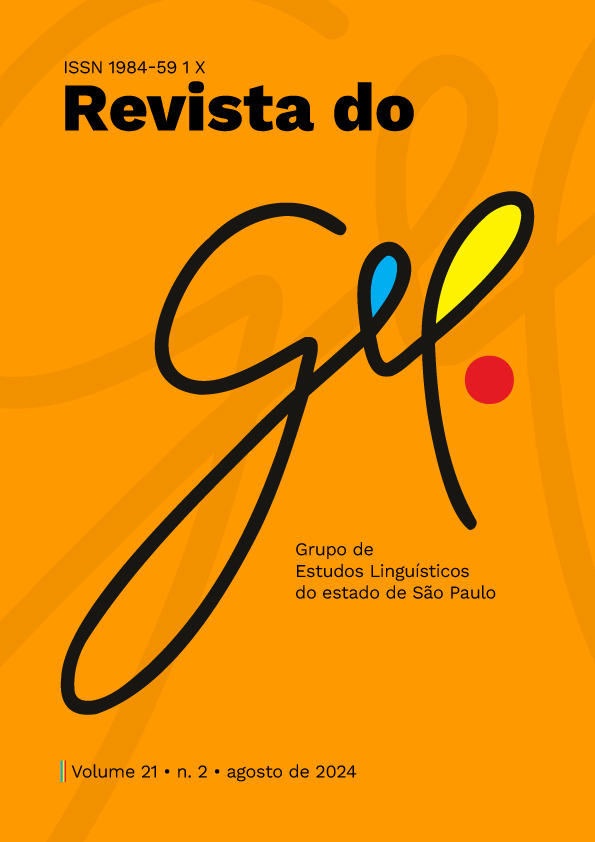Alternantes minoritárias no plural de nomes terminados em <ão> no português brasileiro: contextos favorecedores
Minority alternants in the plural of nouns ending in <ão> in Brazilian Portuguese: favoring contexts
DOI :
https://doi.org/10.21165/gel.v21i2.3752Mots-clés :
Plurais irregulares. Ditongo nasal. Morfofonologia. Logatomas.Résumé
Neste trabalho, aborda-se o fenômeno da flexão de número de nomes terminados pelo ditongo nasal <ão> no português brasileiro. Em especial, problematizam-se os contextos linguísticos que resistem à predominância da alternante de plural <ões>. Os dados que subsidiam a análise advêm de um experimento linguístico proposto para avaliar o juízo de falantes do português brasileiro sobre a melhor alternativa de pluralização de pseudopalavras consideradas as alternantes atestadas no léxico da língua: <ões>, <ãos>, <ães>. O modelo de regressão logística de efeitos mistos gerado para a análise dos resultados aponta para o favorecimento das alternantes minoritárias <ãos> e <ães> para marcar o plural no contexto de pseudopalavras terminadas em <ão> monossilábicas, paroxítonas e portadoras de sufixo gentílico.
Téléchargements
Références
ABAURRE, M. B. Alguns casos de formação de plural em português: uma abordagem natural. Cadernos de Estudos Linguísticos, v. 5, p. 127-156, 1983. Disponível em: https://periodicos.sbu.unicamp.br/ojs/index.php/cel/article/view/8636631/4350. Acesso em: 19 ago. 2024.
ARONOFF, M.; ANSHEN, F. Morphology and the Lexicon: Lexicalization and Productivity. In: SPENCER, A.; ZWICKY, A (ed.). The handbook of morphology. Oxford: Blackwell Publishers, 1998. p. 237-247.
BAAYEN, R. H. On frequency, transparency and productivity. In: BOOIJ, G.; VAN MARLE, J. (ed.). Yearbook of morphology 1992. Dordrecht: Kluwer, 1993. p. 181-208.
BAAYEN, H. Analysing linguistic data: a practical introduction to Statistics. Cambridge: Cambridge University Press, 2008.
BAUER, L. Morphological Productivity. Cambridge: Cambridge University Press, 2001.
BAUER, L. Introducing linguistic morphology. Edinburgh: Edinburgh University Press, 1988.
BECKER, M.; NEVINS, A.; LEVINE, J. Asymmetries in generalizing alternations to and from initial syllables. Language, v. 88, n. 2, p. 231-268, 2012.
BISOL, L. A nasalidade fonológica no português e suas restrições. Diadorim, v. especial, p. 116-126, 2016. Disponível em: https://revistas.ufrj.br/index.php/diadorim/article/view/4050. Acesso em: 19 ago. 2024.
BISOL, L. A Nasalidade, um Velho Tema. DELTA, v. 14, p. 27-46, 1998.
CAMARA JR., J. M. Estrutura da Língua Portuguesa. Rio de Janeiro: Editora Vozes, 1970.
CAMARA JR., J. M. Problemas de Linguística Descritiva. Rio de Janeiro: Editora Vozes, 1969.
CARDEIRA, E.; VILLALVA, A. Gentílicos e topónimos portugueses: algumas questões. Revista GTLex, v. 6, n. 1, p. 192–213, 2020. Disponível em: https://seer.ufu.br/index.php/GTLex/article/view/57353. Acesso em: 19 ago. 2024.
CRISTÓFARO SILVA, T. Organização fonológica de marcas de plural no português brasileiro: uma abordagem multirrepresentacional. Revista da Abralin, v. 11, p. 273-306, 2012. Disponível em: https://revista.abralin.org/index.php/abralin/article/view/1141. Acesso em: 19 ago. 2024.
GARCIA, G. D. Word Generator: an R script for generating pseudo-random words. GitHub Repository, 2014. Disponível em: https://github.com/guilhermegarcia/r/blob/master/word_generator.md. Acesso em: 19 ago. 2024.
HUBACK, A. P. Plurais em -ão do português brasileiro: efeitos de frequência. Revista Linguística, v. 6, p. 9-28, 2010.
LEVSHINA, N. How to do linguistics with R: data exploration and statistical analysis. Amsterdam: John Benjamins Publishing Co., 2015.
MATEUS, M. H.; D’ANDRADE, E. The Phonology of Portuguese. Oxford: Oxford University Press, 2000.
MORALES-FRONT, A.; HOLT, E. The interplay of morphology, prosody, and faithfulness in Portuguese pluralization. In: MARTÍNEZ-GIL, F.; MORALES-FRONT, A. Issues in the Phonology and Morphology of the Major Iberian languages. Washington, D. C: Georgetown University Press, 1997. p. 392-437.
NEVINS, A. A utilidade de logatomas e línguas inventadas na fonologia experimental. Caderno de Squibs, v. 2, p. 67-78, 2016.
OUSHIRO, L. Introdução à estatística para linguistas. Editora da Abralin, 2023. Disponível em: https://editora.abralin.org/publicacoes/introducao-a-estatistica-para-linguistas/. Acesso em: 19 ago. 2024.
R CORE TEAM. R: A language and environment for statistical computing. R Foundation for Statistical Computing, Vienna, Austria, 2023. Disponível em: https://www.R-project.org/. Acesso em: 19 ago. 2024.
SCHWINDT, L. C.; ABAURRE, M. B. On the emergence of [n] in the derivation of nasal-final words in Brazilian Portuguese. Journal of Speech Sciences, v. 11, 2022. Disponível em: https://econtents.bc.unicamp.br/inpec/index.php/joss/article/view/16537. Acesso em: 19 ago. 2024.
SCHWINDT, L. C. Underlying representation of [w]-final words in Brazilian Portuguese: Evidence from morphological derivation. Acta Linguística Academica, v. 68, p. 139-157, 2021. Disponível em: https://akjournals.com/view/journals/2062/68/1-2/article-p139.xml. Acesso em: 19 ago. 2024.
SCHWINDT, L. C.; GAGGIOLA, P. E.; PETRY, I. P. Frequência e distribuição de plurais irregulares no Corpus Brasileiro. Revista Estudos da Linguagem, Belo Horizonte, v. 29, n. 2, p. 1-35, 2021. Disponível em: http://www.periodicos.letras.ufmg.br/index.php/relin/article/view/17466. Acesso em: 19 ago. 2024.
SPENCER, A. Morphological theory: an introduction to word structure in generative grammar. Malden, Massachusetts: Blackwell, 1991.
WETZELS, L. Mid vowel alternations in the Brazilian Portuguese verb. Phonology, v. 12, p. 281-304, 1995.
WETZELS, L. The Lexical representation of Nasality in Brazilian Portuguese. Probus, v. 9, n. 2, p. 203-232, 1997.
Téléchargements
Publié-e
Comment citer
Numéro
Rubrique
Licence
© Revista do GEL 2025

Cette œuvre est sous licence Creative Commons Attribution - Pas d'Utilisation Commerciale 4.0 International.
Esta revista oferece acesso livre imediato ao seu conteúdo, seguindo o princípio de que disponibilizar gratuitamente o conhecimento científico ao público proporciona maior democratização mundial do conhecimento.
A REVISTA DO GEL não cobra taxa de submissão ou de editoração de artigos (articles processing charges – APC).
Os critérios gerais de direitos autorais da REVISTA DO GEL estão dispostos no termo de direitos autorais que cada autor aceita ao submeter seu trabalho no periódico. Como regra geral o periódico utiliza as regras CC BY-NC da Creative Commons (regra disponível em: https://creativecommons.org/licenses/by-nc/4.0/legalcode)



